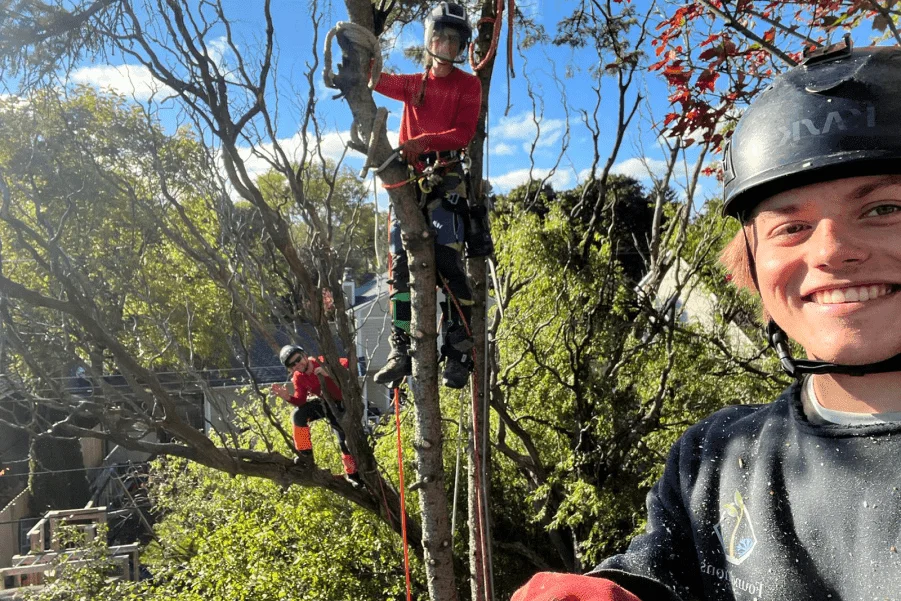A cultivar of the callery pear tree, Bradford pears have gotten a bad rap. But why? They look nice for a couple weeks in the spring, they’re pretty resistant to disease, they don’t drop nuts or berries all over my lawn—what’s to hate? First, let’s be fair and start with the positives.
It’s true that Bradford pears are very pretty when they bloom in the early spring with their many many densely-packed white flowers. It’s also true that they’re famously resistant to many diseases (particularly fireblight.) They’re relatively safe from damage from insects and animals, as they don’t make good homes and produce nothing those animals want to eat. They grow very easily and very fast in lots of different environments, soil compositions, climates, etc, and they require no maintenance. This may all sound appealing if you’re interested in a tree that looks nice and doesn’t require you to do anything. Here are several reasons to think again.
They’re Weak.
When two branches form a tight union (with a narrow angle between them,) that union is going to be weak. We call this included bark—the bark from each of those limbs grows toward the other, slowly pushing the limbs apart from each other and weakening them until one of them is removed, intentionally or otherwise. The branching structure of a Bradford pear is chock full of included bark. For this reason, they’ll break apart without warning in snow, rain, wind, or even if you just leave your ceiling fan on too long. This makes them one of the leading culprits for “tree fell on house” Google searches. Admittedly, they don’t often cause any sort of catastrophic damage since they’re not very big and not very heavy. But mailboxes, fences, and convertibles beware.
They Stink.
There’s not a whole lot to say on this one. When Bradford pears bloom in the spring, they look nice—but plug your nose. They have a strong odor that’s been compared to that of dead fish, sewage, and a host of other things that I feel are not appropriate to write in this blog. But you’ve got the internet.
They’re Invasive (sort of.)
“Invasive” is a tricky word. Technically, in the United States, each state’s Department of Natural Resources determines what species will be considered “invasive” in that state. For now, Michigan’s DNR says that Bradford pears are all right. (In fact, only two species are actually considered invasive here—black locust and tree-of-Heaven. Buckthorn is also invasive, but the DNR doesn’t consider that a tree.)
However, many states have decided differently. At the time of writing this, these trees are considered invasive in 29 states. At least three of them (Ohio, Pennsylvania, and South Carolina) have made it illegal to sell or plant them. North Carolina and Kentucky have even offered residents bounties (yeah, actual bounties!) to cut down their Bradford pears.
They’re Allelopathic.
Bradford pears are allelopathic (uh-LEEL-uh-pa-thik.) This means that their root systems produce chemicals that inhibit the growth (and survival) of other plants in the area. They’re not exactly unique in this—other trees, like black walnuts and sugar maples, also have allelopathic properties. And to be sure, this is not always a bad thing—these same chemicals help to prevent the growth of weeds and other unwanted plants. It does, however, need to be considered. You may have a hard time successfully planting another tree nearby, and as the pear tree grows, so does its allelopathic radius.
They’re Short-Lived.
Perhaps, considering all of the above, this is actually good thing. Still, it ought to be considered. When most people choose a tree to plant, they’re investing in the future of their landscape—often decades in the future. Many trees will outlive all of us. Our kids will climb them, fall out of them, and then hang a tire swing for their kids to use. That’s not the case for a Bradford pear—their average life expectancy is 20-25 years. They grow faster than their wood can really support, and they tend to break apart even well before that 25-year mark.
Conclusion:
If you’re considering planting a Bradford pear, at least think twice about it. For each of their positive properties, there’s a better option with the same characteristics. If you like the white flowers in the spring, consider a serviceberry or a flowering dogwood. If you like the minimal maintenance, consider a Japanese maple or an eastern redbud.
If you’ve already got one and are wondering what to do with it, give us a call. We’ll come take a look and tell you if it’s in good shape, if it could use some structural pruning, or if it’s time has come. Everything on this earth has a lifespan, and if your Bradford pear has been there since “before you even bought the house,” it may be time.

